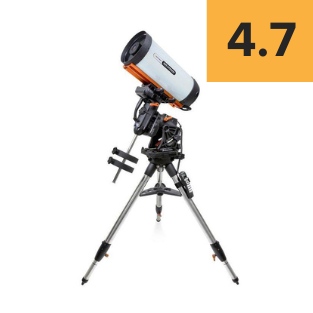Rank Category: Computerized Telescopes in the ~$4500-$6500 range

Reasons Why I Often Recommend Manual Telescopes Over Computerized Ones
Except for the Celestron NexStar Evolution telescopes and a few other costlier telescopes, almost every computerized telescope requires a portable power supply, either a 12-volt lead-acid rechargeable DC battery or lithium-ion rechargeable batteries. Either adds cost to your scope and has to be hauled around. I’ve used AA batteries as backups in some telescopes, but they quickly guzzle them within a few observing sessions, and I found it to be expensive to continually replenish them. So, I’d advise you to budget at least $50 for a power supply.
GoTo technology has been around for three and a half decades now. Yet I see many computerized telescopes having an interface basically the same as it had 20 years ago, with a small hand controller with the processing abilities of a pocket calculator, a small LCD screen with calculator-like text, and many functional limitations. Most computerized scopes still have no internal clocks and require re-alignment if power is lost, even briefly.
However, newer models like SkyWatcher’s Virtuoso series and Celestron’s StarSense Explorer series, among many others, are exceptions.
Most computerized telescopes have an advertised feature that supposedly lets us quickly align their GoTo system by using any three bright sky objects or by simply pointing the scope north and leveling the scope with the horizon. But from my vast experience, neither works accurately, and most of the time, I end up having to align on two known bright stars. But for you to do this, you need to have a basic understanding of the motions of the sky and some bright stars to find in the sky.
I also experience occasional failures and weird behaviors requiring hours of troubleshooting—hours that could be spent looking through a manual telescope’s eyepiece instead.
If you ask me, star charts and observing books like Turn Left at Orion are much more interesting and engaging to read than the user manual of a Go-To telescope. Also, learning star hops in online forums is more interesting and engaging than consulting troubleshooting forums.
And it is indeed more fun to manually point a telescope, following star-hops to figure out where an object is in the sky. It’s more fun because it’s more engaging and it gives you something to do. By learning to find objects, you’re learning the night sky. You’re learning to navigate it, to go from place to place, to learn which objects are in the neighborhood.
However, the pros may outweigh the cons for you depending on your situation and there’s absolutely no shame in owning a computerized instrument.
















I own an old nexstar 4 . The hand control failed although the direction buttons still work. I have a large tripod, a full set of eyepieces and filters, and a sun filter. What can I purchase that would be reliable and utilize some of my old accessories. I would want to have minimal alignment or setup requirements.
Thank you for this site. My brother and his family are going to moving into a new home in a secluded area where they should be surrounded by beautiful dark skies and nature, and I want to gift them a telescope as a housewarming. Honestly, I do not feel we have any future astronomers among the group, but I would like to give them something sturdy and amateur user friendly. I like the idea of giving them a “push to” or “go-to” telescope. I was looking at the Meade StarNavigator NG based on the Space.com site, but I see it is not a recommendation for you. Can you help me determine what I should be looking at given what I have shared, please? Thank you for your consideration
https://telescopicwatch.com/celestron-cpc-1100-gps-review/
Hello, I ordered the Sky-Watcher Virtuoso GTI 150P and am excitedly waiting for the same. What accessories do you suggest? This will be my first telescope and will be observing more from the backyard. Thinking of a simple step stool for the table to setup the telescope. Guessing eyepieces are the most importan accessory I need. No specific budget, looking for best value rather than lowest price or maximum performance. I wear glasses for short sight and will be with my 6y daughter who does not. Do eye pieces come with diopter adjustment like binoculars? Thinking of binoviewers for planetary watching so may be buying double the eyepieces. Lots of light pollution from street lights and neighbors so will likely need a shroud. What would you recommend? Thanks!
You don’t need a diopter adjustment or anything like that, just focus for your own eyesight. Binoviewers have diopters.